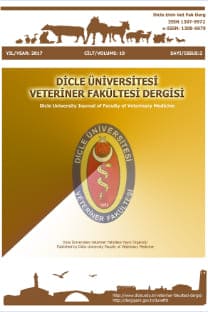Blastocystis sp.'nin İnsanlara Bulaşında İnsanlarla Yakın İlişkili Hayvanların Rolü
The Role of Inhabited Animals With People in Human Transmission of Blastocystis sp.
___
- Arisue N, Hashimoto T, Yoshikawa H, et al (2002): Phylogenetic position of Blastocystis hominis and of Stramenopiles inferred from multiple molecular sequence data. J Eukaryot Microbiol, 49:42-53.
- Tan KS (2008):. New insights on classification, identification, and clinical relevance of Blastocystis spp. Clinical Microbiology Reviews,21, 639-65.
- Yakoob J, Jafri W, Beg MA, et al (2010): Irritable bowel syndrome: is it associated with genotypes of Blastocystis hominis. Parasitol Res, 106, 1033-8.
- Balint A, Doczi I, Bereczki L et al (2014): Do not forget the stool examination!-cutaneous and gastrointestinal manifestations of Blastocystis sp infection. Parasitol Res, 113, 1585-90.
- Lepczynska M, Chen WC, Dzika E (2016): Mysterious chronic urticaria caused by Blastocystis spp.? Int J Dermatol, 55, 259-66.
- AL FD, Hökelek M (2007): Blastocystis hominis Fırsatçı Bir Patojen mi? Türkiye Parazitol Derg, 31, 28-36.
- Ramirez JD, Sanchez A, Hernandez C et al (2016): Geographic distribution of human Blastocystis subtypes in South America. Infect Genet Evol, 41, 32-5.
- Navarro C, Domínguez-Márquez M, Garijo-Toledo M et al (2008): High prevalence of Blastocystis sp. in pigs reared under intensive growing systems: frequency of ribotypes and associated risk factors. Veterinary parasitology, 153, 347-58.
- Greige S, El Safadi D, Bécu N et al (2018): Prevalence and subtype distribution of Blastocystis sp. isolates from poultry in Lebanon and evidence of zoonotic potential. Parasites & vectors, 11, 389.
- Tan KS, Mirza H, Teo JD et al (2010): Current views on the clinical relevance of Blastocystis spp. Current infectious disease reports, 12, 28-35.
- Yoshikawa H, Tokoro M, Nagamoto T et al (2016): Molecular survey of Blastocystis sp. from humans and associated animals in an Indonesian community with poor hygiene. Parasitology international 65, 780-4.
- Yan Y, Su SL, Ye JH et al (2007): Blastocystis sp subtype 5: a possibly zoonotic genotype. Parasitol Res, 101, 1527-32.
- Stensvold CR, Alfellani MA, Norskov-Lauritsen S et al (2009): Subtype distribution of Blastocystis isolates from synanthropic and zoo animals and identification of a new subtype. Int J Parasitol, 39, 473-9.
- Noel C, Dufernez F, Gerbod D et al (2005): Molecular phylogenies of Blastocystis isolates from different hosts: Implications for genetic diversity, identification of species, and zoonosis. Journal of Clinical Microbiology, 43, 348-55.
- Ramirez JD, Sanchez LV, Bautista DC et al (2016): Blastocystis subtypes detected in humans and animals from Colombia. Infect Genet Evol, 22, 223-8.
- Fayer R, Santin M, Macarisin D. (2012): Detection of concurrent infection of dairy cattle with Blastocystis, Cryptosporidium, Giardia, and Enterocytozoon by molecular and microscopic methods. Parasitol Res, 111, 1349-55.
- Cian A, El Safadi D, Osman M, Moriniere R et al (2017): Molecular Epidemiology of Blastocystis sp. in Various Animal Groups from Two French Zoos and Evaluation of Potential Zoonotic Risk. PloS one, 12, e0169659.
- Stensvold CR, Suresh GK, Tan KS et al (2007): Terminology for Blastocystis subtypes–a consensus. Trends in parasitology, 23, 93-6.
- Clark CG (1997): Extensive genetic diversity in Blastocystis hominis. Molecular and biochemical parasitology, 87, 79-83.
- Lee H, Lee S-H, Seo M-G et al (2018): Occurrence and genetic diversity of Blastocystis in Korean cattle. Veterinary Parasitology, 258, 70-3.
- Zhu W, Tao W, Gong B et al (2017): First report of Blastocystis infections in cattle in China. Veterinary parasitology, 246, 38-42.
- Bohm-Gloning B, Knobloch J, Walderich B (1997): Five subgroups of Blastocystis hominis from symptomatic and asymptomatic patients revealed by restriction site analysis of PCR-amplified 16S-like rDNA. Trop Med Int Health, 2(8), 771–778.)
- Yoshikawa H, Iwamasa A. (2016): Human Blastocystis subtyping with subtype-specific primers developed from unique sequences of the SSU rRNA gene. Parasitology international, 65, 785-791.
- Roberts T, Barratt J, Harkness J et al (2011): Comparison of Microscopy, Culture, and Conventional Polymerase Chain Reaction for Detection of Blastocystis sp in Clinical Stool Samples. Am J Trop Med Hyg, 84, 308-12.
- Santos HJ, Rivera WL (2011): Comparison of direct fecal smear microscopy, culture, and polymerase chain reaction for the detection of Blastocystis sp in human stool samples. Asian Pac J Trop Med, 6, 780-4.
- Parkar U, Traub RJ, Kumar S et al (2007): Direct characterization of Blastocystis from faeces by PCR and evidence of zoonotic potential. Parasitology, 134, 359-67.
- Alfellani MA, Taner-Mulla D, Jacob AS et al (2013): Genetic Diversity of Blastocystis in Livestock and Zoo Animals. Protist, 164, 497-509.
- Thathaisong U, Worapong J, Mungthin M et al (2003): Blastocystis isolates from a pig and a horse are closely related to Blastocystis hominis. Journal of Clinical Microbiology, 41, 967-75.
- ISSN: 1307-9972
- Yayın Aralığı: 2
- Başlangıç: 2008
- Yayıncı: Dicle Üniversitesi Veteriner Fakültesi
Parvoviral Enteritise Bağlı Septik veya Septik Olmayan Köpeklerde Hematolojik Durum
A. Ezgi TELLİ, Nihat TELLİ, Yusuf DOĞRUER, Yusuf BİÇER
Gebeliğin Sonunda Uygulanan Enerji Eksikliğinin Koyun ve Kuzu Doğum Ağırlıkları Üzerine Etkisi
Mehmet Hanifi DURAK, Atila ATEŞ, Tanay BİLAL
Blastocystis sp.'nin İnsanlara Bulaşında İnsanlarla Yakın İlişkili Hayvanların Rolü
Fatih ÇAKIR, Akın KOÇHAN, Muttalip ÇİÇEK, Hasan İÇEN, İbrahim Halil YILDIRIM
Propolis ve Ruminantlarda Alternatif Yem Katkı Maddesi Olarak Kullanımı
Gülşah SARAL, Firdevs BİNLİ, Serhan Serhat AY
Farklı Kedi Irklarının Testislerinde Sitokeratin 8’in İmmunohistokimyasal Lokalizasyonu
Zelal KARAKOÇ, Uğur TOPALOĞLU, Mehmet Erdem AKBALIK, Berna GÜNEY SARUHAN, Nurşin AYDIN
Kırıkkale İlinde Kesilen Simental Irkı Sığırların Bazı Kesim ve Karkas Özellikleri
